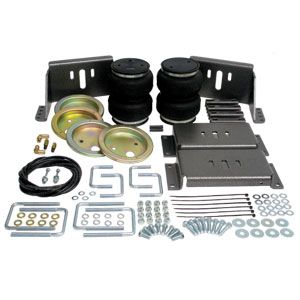DEF Injector Diagnostics and Replacement
- May 01, 2023
1
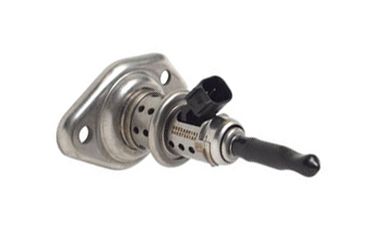
DEF INJECTOR DIAGNOSTICS AND REPLACEMENT
If you own a 2013 or newer Ram, you have seen quite a few articles about the DEF system in the Turbo Diesel Register magazine. The most recent: Issue 115 and Stan Gozzi’s article “DEF Pump and Sensor,” pages 98-99.
So, when you start your truck and you have a new message on your EVIC: Service DEF System See Dealer, you think, “Well, what I am in for now?” Hopefully, all I have to do is clean an injector (Issue 109, pages 106-109). Hopefully, it’s not the pump (noted price from Issue 115, $1365). Thankfully, I did not get the message that I will go into “limp” mode in so many miles.
However, by the next day I had an updated message: Engine Will Not Restart in 150 miles. Service DEF System See Dealer. Now the countdown was on.
The good news for me is that I am not 1,000 miles from home in a remote location. I am home and I work for the TDR and Geno’s Garage, and I have access to parts and information. I can only imagine the sense of dread to be out in the middle of nowhere and facing the possibility of going into limp mode.
FAULT CODES
When the message appeared on the EVIC, I was surprised that it did not set a check engine light. However, when I got to the shop, I checked the codes. I found that I had a code P2048 (Reluctant Injector Circuit). Not knowing what this code meant, I checked my back issues of the TDR to see if this had been covered. Then I hopped on the internet and did a quick search. It seems that this code can be a problem with the ECM, wiring, or a faulty DEF injector. According to our friend David Pike who has a popular YouTube channel called “Motor City Mechanic,” the easiest place to start would be to diagnose the injector and leave the electrical stuff until last.
Feeling confident with David's suggestion, I grabbed the necessary tools:
A 10mm wrench,
multimeter,
and a small flat blade screwdriver.
The injector is located on the inlet side of the Selective Catalytic Reducer (SCR) on the top.
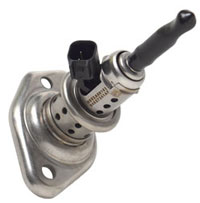
The injector is not difficult to access. While it may be a little tight, I had no problems accessing any of the bolts or harnesses. You may be able to do the resistance test without removing the injector, but you really need another set of hands if you are going to try and hold the multimeter and probe the two wires. With only two 10mm bolts to remove, I decided to go ahead and remove the injector. After all, it probably wouldn’t hurt to be cleaned anyway. (Word of advice. If you have corrosion issues you may want to presoak the two bolts with penetrating oil to help with removal.)
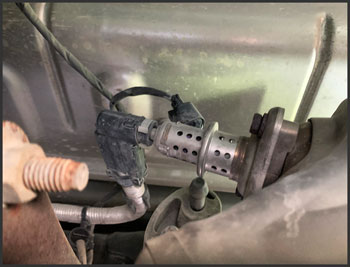
Removal of the injector itself was not too difficult. However, the DEF inlet hose and electrical connector are another story. When removing the wiring harness, you will want to take a small flat blade screwdriver to push the red locking tab outwards towards the wires. Once this is pushed out you can depress the tab and remove the harness. Next you will want to remove the DEF supply line. This is a little more difficult. You will want to press the fitting into the injector while simultaneously pushing the gray locking tab out to the side. Once the gray locking tab is pushed out, you can remove the supply line.
TESTING
With the injector removed you can now check the resistance (ohms) of the injector with your multi-meter. According to the service manual, a good injector will have a resistance reading between 11 to 13 ohms. I checked mine and it had an open circuit which confirmed that I had a faulty injector. I did not have to go any further diagnosing the problem (or at least I hoped). I would not know for sure until everything was reinstalled and I restarted the engine.
INSTALLATION
I had already purchased an injector (part #4627241AF $207.95 from Geno’s Garage). Just to be certain, I decided to test it before the installation and sure enough it checked out at 13 ohms.
Before installing the new injector, you will want to make sure that the mating surface of the opening is clean. I ended up using a razor blade, scraped away the remaining fiber gasket material and finished it with a small sanding pad.
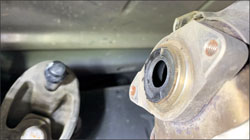
With the surface clean you can now install the new injector and tighten the two mounting bolts (8 ft-lbs.). Reinstall the DEF supply line and the electrical connector and you should be good to start the truck.
Now for the big moment. I started the truck and the message was gone. (Thankfully!) Next, I checked for codes and deleted the code P2048. Success. The code did not return and I am back on the road. Thankfully this worked out well. I was lucky.
CONCLUSION
I am relieved that this was a faulty injector. It is unfortunate that the manufacturers are required to put limits on the miles driven when there is a faulty emissions component. This forces people to do whatever it takes to get home—and at whatever costs. We have all heard the many stories of people paying several thousands of dollars to repair or replace DEF system components when all they had to do was either clean the tank or replace (possibly clean) the injector.
by Brandon Parks, Turbo Diesel Register / Published in the TDR Issue #116 Spring 2022
References:
TDR Issue #102 “The Rest of the Story” – Stan Gozzi - pages 104-106
The System TDR Issue #109 “The Rest of the Story” – Stan Gozzi - pages 106-109
DEF Concentration Test and Injector Cleaning TDR Issue #112 “Technical Topics” – Tracy Martin and Robert Patton - pages 16-25
Diesel SCR Service TDR Issue #114 “The Rest of the Story” – Stan Gozzi - pages 106-107
Service DEF System, Code P207F TDR Issue #115 “The Rest of the Story” – Stan Gozzi - pages 98-99
YouTube: MotorCity Mechanic on YouTube – Search for DEF Injector within their channel
If you own a 2013 or newer Ram, you have seen quite a few articles about the DEF system in the Turbo Diesel Register magazine. The most recent: Issue 115 and Stan Gozzi’s article “DEF Pump and Sensor,” pages 98-99.
So, when you start your truck and you have a new message on your EVIC: Service DEF System See Dealer, you think, “Well, what I am in for now?” Hopefully, all I have to do is clean an injector (Issue 109, pages 106-109). Hopefully, it’s not the pump (noted price from Issue 115, $1365). Thankfully, I did not get the message that I will go into “limp” mode in so many miles.
However, by the next day I had an updated message: Engine Will Not Restart in 150 miles. Service DEF System See Dealer. Now the countdown was on.
The good news for me is that I am not 1,000 miles from home in a remote location. I am home and I work for the TDR and Geno’s Garage, and I have access to parts and information. I can only imagine the sense of dread to be out in the middle of nowhere and facing the possibility of going into limp mode.
FAULT CODES
When the message appeared on the EVIC, I was surprised that it did not set a check engine light. However, when I got to the shop, I checked the codes. I found that I had a code P2048 (Reluctant Injector Circuit). Not knowing what this code meant, I checked my back issues of the TDR to see if this had been covered. Then I hopped on the internet and did a quick search. It seems that this code can be a problem with the ECM, wiring, or a faulty DEF injector. According to our friend David Pike who has a popular YouTube channel called “Motor City Mechanic,” the easiest place to start would be to diagnose the injector and leave the electrical stuff until last.
Feeling confident with David's suggestion, I grabbed the necessary tools:
A 10mm wrench,
multimeter,
and a small flat blade screwdriver.
The injector is located on the inlet side of the Selective Catalytic Reducer (SCR) on the top.

The injector is not difficult to access. While it may be a little tight, I had no problems accessing any of the bolts or harnesses. You may be able to do the resistance test without removing the injector, but you really need another set of hands if you are going to try and hold the multimeter and probe the two wires. With only two 10mm bolts to remove, I decided to go ahead and remove the injector. After all, it probably wouldn’t hurt to be cleaned anyway. (Word of advice. If you have corrosion issues you may want to presoak the two bolts with penetrating oil to help with removal.)

Removal of the injector itself was not too difficult. However, the DEF inlet hose and electrical connector are another story. When removing the wiring harness, you will want to take a small flat blade screwdriver to push the red locking tab outwards towards the wires. Once this is pushed out you can depress the tab and remove the harness. Next you will want to remove the DEF supply line. This is a little more difficult. You will want to press the fitting into the injector while simultaneously pushing the gray locking tab out to the side. Once the gray locking tab is pushed out, you can remove the supply line.
TESTING
With the injector removed you can now check the resistance (ohms) of the injector with your multi-meter. According to the service manual, a good injector will have a resistance reading between 11 to 13 ohms. I checked mine and it had an open circuit which confirmed that I had a faulty injector. I did not have to go any further diagnosing the problem (or at least I hoped). I would not know for sure until everything was reinstalled and I restarted the engine.
INSTALLATION
I had already purchased an injector (part #4627241AF $207.95 from Geno’s Garage). Just to be certain, I decided to test it before the installation and sure enough it checked out at 13 ohms.
Before installing the new injector, you will want to make sure that the mating surface of the opening is clean. I ended up using a razor blade, scraped away the remaining fiber gasket material and finished it with a small sanding pad.

With the surface clean you can now install the new injector and tighten the two mounting bolts (8 ft-lbs.). Reinstall the DEF supply line and the electrical connector and you should be good to start the truck.
Now for the big moment. I started the truck and the message was gone. (Thankfully!) Next, I checked for codes and deleted the code P2048. Success. The code did not return and I am back on the road. Thankfully this worked out well. I was lucky.
CONCLUSION
I am relieved that this was a faulty injector. It is unfortunate that the manufacturers are required to put limits on the miles driven when there is a faulty emissions component. This forces people to do whatever it takes to get home—and at whatever costs. We have all heard the many stories of people paying several thousands of dollars to repair or replace DEF system components when all they had to do was either clean the tank or replace (possibly clean) the injector.
by Brandon Parks, Turbo Diesel Register / Published in the TDR Issue #116 Spring 2022
References:
TDR Issue #102 “The Rest of the Story” – Stan Gozzi - pages 104-106
The System TDR Issue #109 “The Rest of the Story” – Stan Gozzi - pages 106-109
DEF Concentration Test and Injector Cleaning TDR Issue #112 “Technical Topics” – Tracy Martin and Robert Patton - pages 16-25
Diesel SCR Service TDR Issue #114 “The Rest of the Story” – Stan Gozzi - pages 106-107
Service DEF System, Code P207F TDR Issue #115 “The Rest of the Story” – Stan Gozzi - pages 98-99
YouTube: MotorCity Mechanic on YouTube – Search for DEF Injector within their channel
1 Comment(s)
HKP
May 02, 2023 13:22
Good information, now I'll try not to panic if I see that EVIV message on my dashboard.




